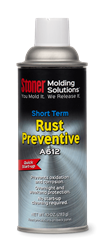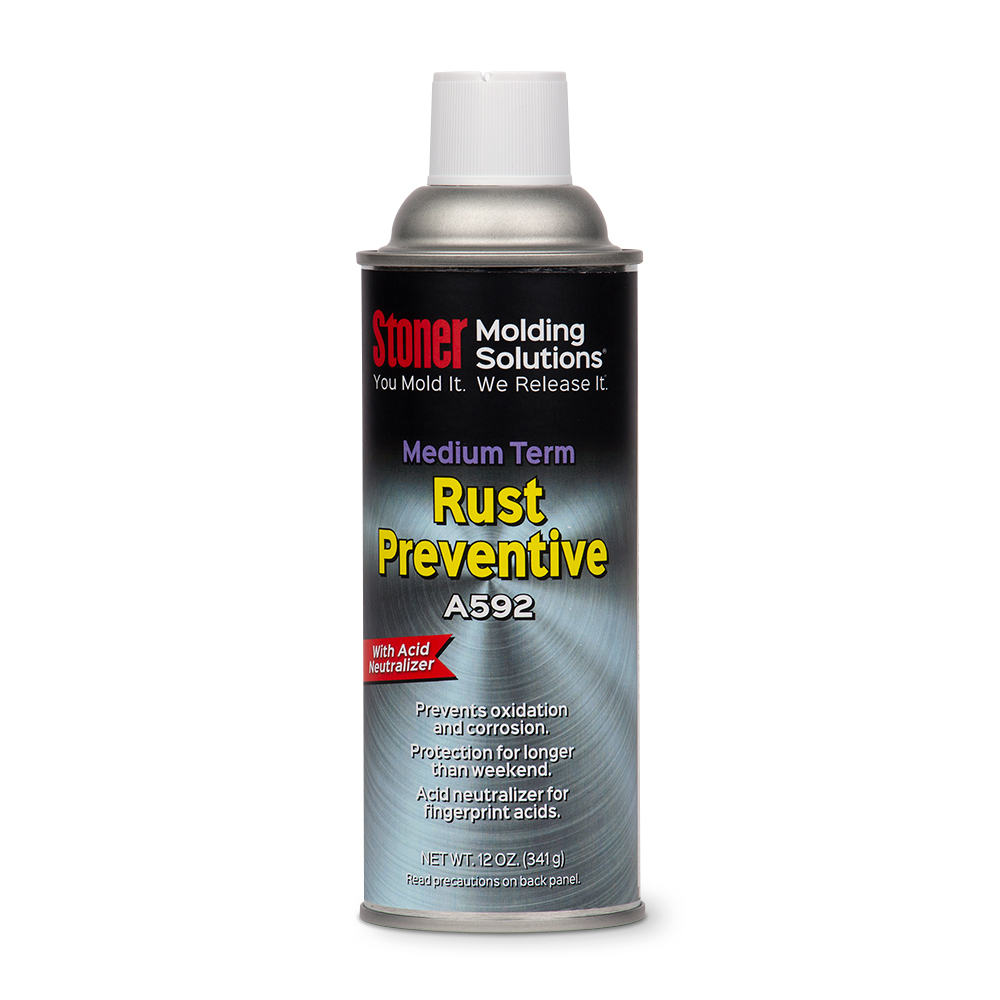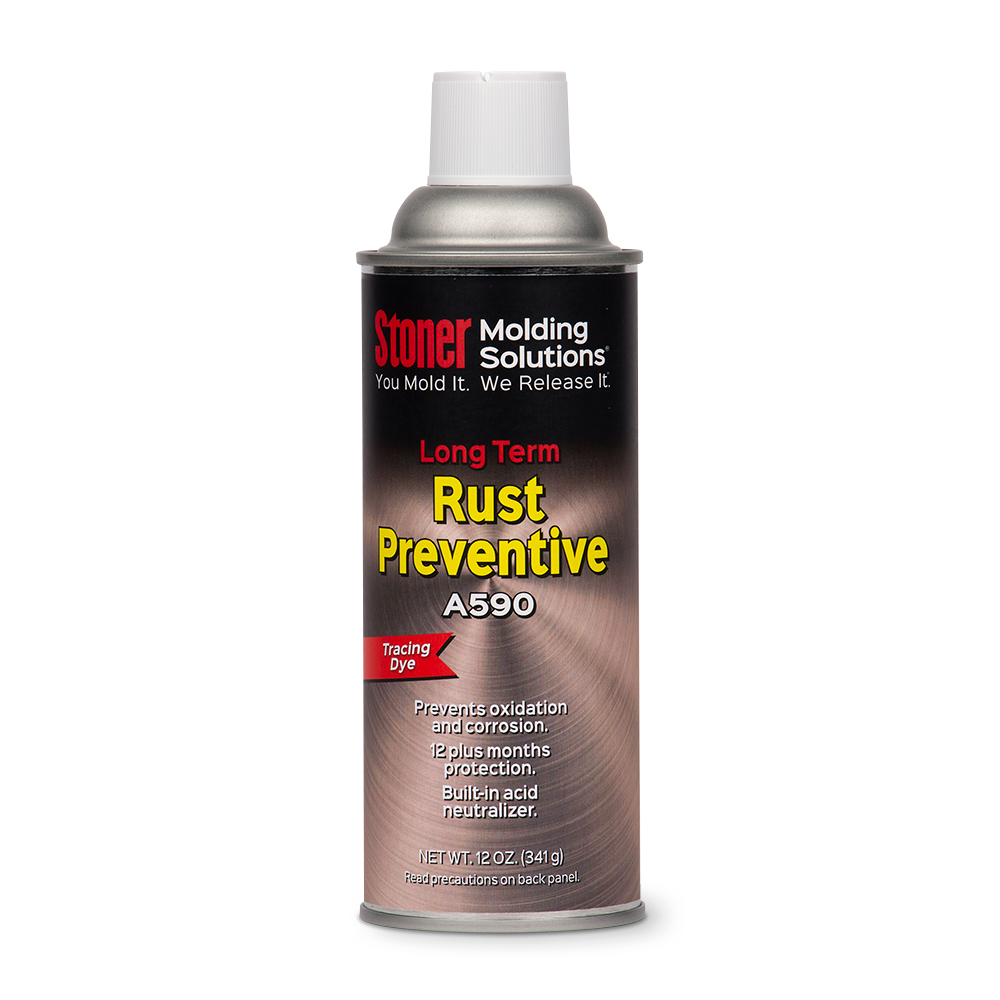6 FAQs about Preventing Corrosion in Molds with Rust Protection Spray
 Rust. It is a small word that causes big problems. If your industrial molding facility uses carbon steel or any other type of metal molds, you are at risk of developing this problem. Rust and corrosion cause many issues in molding operations, such as:
Rust. It is a small word that causes big problems. If your industrial molding facility uses carbon steel or any other type of metal molds, you are at risk of developing this problem. Rust and corrosion cause many issues in molding operations, such as:
- Prematurely killing a mold
- Requiring additional labor and supply costs to remove the rust
- Increasing downtime
- Damaging presses and other molding machinery
Like most molding companies, you simply can’t afford to replace an expensive mold every few years because rust corrodes away its surface or to have workers waiting around while rust is removed from a mold. Unfortunately, traditional rust protection sprays clog mold pores and require even more work to clean them off before you can use the mold.
The good news is that there is a way to prevent rust from forming and premature mold damage without clogging pores. All you must do is use one of our four spray-on rust inhibitors. We have the rust prevention spray you need for short-term to long-term storage.
1. What Causes Rust to Form on Molds?
Since molds can range in size, there’s often insufficient storage space inside the industrial molding building. This lack of space forces many operations to store molds outside when not in use. The problem is that these molds endure the elements, such as wind, rain, sun, snow, and ice. When these substances come in contact with the metal on the mold, rust can form.
But water and the elements aren’t the only reason rust forms on molds. Even a fingerprint can cause rust to form because of the acid on your skin. In addition, the frequent temperature and pressure changes endured by molds during the molding process can be a reason rust and corrosion form on molds.
2. What Issues Occur When Rust Builds Up on Molds?
Besides mold damage, when rust builds up on molds, it can cause a breakdown or even a complete shutdown of a press. When this happens, you face significant manufacturing downtime and a decrease in productivity. And, if left for too long, the rust will corrode the metal surfaces of the mold, leaving you unable to use it and costing hundreds of thousands of dollars to replace it.
Additionally, if you don’t properly remove the rust and run a production cycle, you may face a quality issue when the rust gets imparted on the molded part. That’s why preventing rust is essential to a successful molding operation.
3. How Do I Prevent Rust on Molds?
 To prevent rust and corrosion from forming on your molds, you need a protective coating that inhibits oxidation and protects against moisture and damage. We have four different rust protection sprays for you to choose from based on the length of time the mold will be stored.
To prevent rust and corrosion from forming on your molds, you need a protective coating that inhibits oxidation and protects against moisture and damage. We have four different rust protection sprays for you to choose from based on the length of time the mold will be stored.
Overnight and Short-Term Storage
When your production has downtime or your molding operations are closed overnight, on a holiday, or over the weekend, our A612 Short-Term Rust Preventative is the ideal solution. This spray-on rust and corrosion inhibitor stops rust from forming on exposed steel and stored metals. It also requires no cleaning before putting the mold back into production, as it naturally wears off during start-up.
 Medium-Term Storage
Medium-Term Storage
When you need to protect metal surfaces from rust for several weeks to several months, A592 Medium Term Rust Preventative is the answer. This rust protection spray leaves a microfilm coating of penetrating lubricant that contains a built-in acid neutralizer. This formula stops rust from forming and protects the metal from the damaging effects of mild acids, alkalis, and fingerprints.

 Long-Term Storage
Long-Term Storage
When you need corrosion protection for longer than a few months, A677 and A590 Long-Term Rust Preventatives can give you long-lasting protection. Both rust prevention sprays protect steel and other metals from moisture, dampness, oxidation, and corrosion. A590 contains a tracing dye that ensures even product coverage, so you are sure not to miss a spot. These sprays adhere to the interior and exterior surfaces of molds, tooling, and slides without sagging.
4. When Should I Use Rust Protection Spray?
You should use our professional-grade rust protection sprays whenever you aren’t using a mold. For example, the short-term rust protection spray should be used when the workday is over, and the mold won’t be used for several hours or days. Perhaps you’re shipping a mold and aren’t sure when it will be used. You should use the rust prevention spray for long-term storage in that case.
5. Who Is Responsible for Rust Prevention on Industrial Molds?
Everyone who works at your industrial molding facility is responsible for preventing rust. There should be a checks and balances system for corrosion control from the molding operators to the maintenance department. Incorporate rust control measures with your mold cleaning procedures for the most effective way to prevent corrosion. Consider placing signage on a mold detailing when you use the rust protective spray so that it’s easy to see at a glance which molds have protection from rust and other corrosion.
6. Where Should I Spray the Spray-On Rust Inhibitor?
The internal surface of the mold that forms the part is the most important area to keep rust-free. When storing a mold, even overnight or between cycles, making sure you use rust protection spray on the inside of the mold is critical.
Additionally, the outside of the mold needs protection. If you put a mold into a molding machine with rust on the outside, the corrosion can wear down the outside of the mold faster once introduced to heat and pressure. The rust may also get into some of the tight clearances and other parts of the machinery. That’s why spraying rust prevention is vital on the inside and outside of the mold.
You must spray the entire surface thoroughly. Spotty coverage will cause rust to appear on some regions of the mold. Our long-term rust prevention, A590, contains a tracing dye that ensures even product coverage for peace of mind.
Need More Tips on Preventing Rust? Contact Stoner Molding Today!
Preventing rust on your industrial molds is an important task. Rust and corrosion lead to poor-quality molded parts, a mold with a decreased lifespan, and downtime. That’s why you need to take steps to protect against rust with our rust protection sprays.
Choose the one that works best for your situation—short, medium, or long-term—to prevent rusted surfaces. Please request a sample today to try it for yourself!
